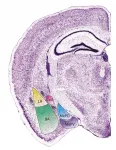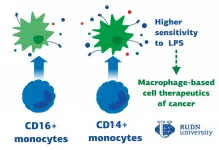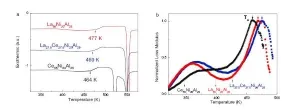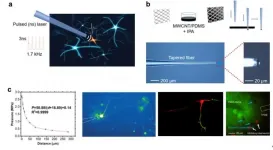How micro-circuits in the brain regulate fear
2021-07-16
(Press-News.org) Fear is an important reaction that warns and protects us from danger. But when fear responses are out of control, this can lead to persistent fears and anxiety disorders. In Europe, about 15 percent of the population is affected by anxiety disorders. Existing therapies remain largely unspecific or are not generally effective, because the detailed neurobiological understanding of these disorders is lacking.
What was known so far is that distinct nerve cells interact together to regulate fear responses by promoting or suppressing them. Different circuits of nerve cells are involved in this process. A kind of "tug-of-war" takes place, with one brain circuit "winning" and overriding the other, depending on the context. If this system is disturbed, for example if fear reactions are no longer suppressed, this can lead to anxiety disorders.
Recent studies have shown that certain groups of neurons in the amygdala are crucial for the regulation of fear responses. The amygdala is a small almond-shaped brain structure in the center of the brain that receives information about fearful stimuli and transmits it to other brain regions to generate fear responses. This causes the body to release stress hormones, change heart rate or trigger fight, flight or freezing responses.
Now, a group led by Professors Stephane Ciocchi of the University of Bern and Andreas Luthi of the Friedrich Miescher Institute in Basel has discovered that the amygdala plays a much more active role in these processes than previously thought: Not only is the central amygdala a "hub" to generate fear responses, but it contains neuronal microcircuits that regulate the suppression of fear responses. In animal models, it has been shown that inhibition of these microcircuits leads to long-lasting fear behaviour. However, when they are activated, behaviour returns to normal despite previous fear responses. This shows that neurons in the central amygdala are highly adaptive and essential for suppressing fear. These results were published in the journal Nature Communications.
"Disturbed" suppression leads to long-lasting fear
The researchers led by Stephane Ciocchi and Andreas Luthi studied the activity of neurons of the central amygdala in mice during the suppression of fear responses. They were able to identify different cell types that influence the animals' behaviour. For their study, the researchers used several methods, including a technique called optogenetics with which they could precisely shut down - with pulses of light - the activity of an identified neuronal population within the central amygdala that produces a specific enzyme. This impaired the suppression of fear responses, whereupon animals became excessively fearful. "We were surprised how strongly our targeted intervention in specific cell types of the central amygdala affected fear responses," says Ciocchi, Assistant Professor at the Institute of Physiology, University of Bern. "The optogenetic silencing of these specific neurons completely abolished the suppression of fear and provoked a state of pathological fear."
Important for developing more effective therapies
In humans, dysfunction of this system, including deficient plasticity in the nerve cells of the central amygdala described here, could contribute to the impaired suppression of fear memories reported in patients with anxiety and trauma-related disorders. A better understanding of these processes will help develop more specific therapies for these disorders. "However, further studies are necessary to investigate whether discoveries obtained in simple animal models can be extrapolated to human anxiety disorders", Ciocchi adds.
This study was carried out in partnership with the University of Bern, the Friedrich Miescher Institute and international collaborators. It was funded by the University of Bern, the Swiss National Science Foundation and the European Research Council (ERC).
Systems Neuroscience Group, Institute of Physiology, University of Bern
Neuronal diversity is a hallmark of cortical networks. In the hippocampus, distinct neuronal cell-types interact together by selective synaptic contacts and neural activity patterns. We investigate how different forms of emotional and cognitive behaviours emerge within intricate neuronal circuits of the ventral CA1 hippocampus, a brain region instrumental for context-specific emotional memories, anxiety and goal-directed actions. We hypothesize that distinct behavioural programs are implemented by the selective recruitment of micro- and large-scale neural circuits of the ventral CA1 hippocampus. To identify these circuit motifs, we are combining single-unit recordings of ventral CA1 GABAergic interneurons and projection neurons, selective optogenetic strategies, cell-type specific viral tracing and behavioural paradigms in rodents. The results of our experimental approaches will determine fundamental neural computations underlying learning and memory within higher cortical brain regions.
INFORMATION:
[Attachments] See images for this press release:

ELSE PRESS RELEASES FROM THIS DATE:
2021-07-16
A new way of producing coherent light in the ultra-violet spectral region, which points the way to developing brilliant table-top x-ray sources, has been produced in research led at the University of Strathclyde.
The scientists have developed a type of ultra-short wavelength coherent light source that does not require laser action to produce coherence. Common electron-beam based light sources, known as fourth-generation light sources, are based on the free-electron laser (FEL), which uses an undulator to convert electron beam energy into X-rays.
Coherent light sources are powerful tools that enable research in many areas of medicine, biology, material sciences, chemistry and physics.
This new way of producing coherent radiation could revolutionise light sources, as it would ...
2021-07-16
In the field of industrial engineering, using simulations to model, predict and even optimise the response of a system or device is widespread, as it is less expensive and less complex -and, sometimes, less dangerous- than fabricating and testing several prototypes.
This type of simulation studies uses numerical methods that, depending on the problem to be addressed -for example, reducing the aerodynamic forces of an aircraft by changing its shape or using the minimum possible amount of material on elements under loading without breaking- require the simulation of a wide variety of possible combinational cases, which entails high computational costs.
The researchers from the School of Industrial Engineering of the University of Malaga Francisco Javier Granados Ortiz ...
2021-07-16
Neuro-evolutionary robotics is an attractive approach to realize collective behaviors for swarms of robots. Despite the large number of studies that have been devoted to it and although many methods and ideas have been proposed, empirical evaluations and comparative analyses are rare.
A publication in the journal Nature Communications, led by Mauro Birattari and his team at the research center IRIDIA, École Polytechnique de Bruxelles, Université Libre de Bruxelles, compares some of the most popular and advanced neuro-evolutionary methods for offline design of robot swarms.
"Concretely, these ...
2021-07-16
RUDN University biologists discovered the way how macrophages (the cells of the "first line" immune response) respond to inflammation and identified how the immune response depends on their origin. It turned out that when exposed to an inflammatory stimulus, two opposing mechanisms are activated in macrophages simultaneously -- inducing and inhibiting inflammation. These data can potentially be useful in the treatment of cancer, as targeted activation of macrophages will strengthen the immune response of the organism in the fight against a tumor. The results were published in the journal Biomedicine & Pharmacotherapy.
Macrophages are the cells responsible for phagocytosis -- they capture bacteria, the dead cells remains ...
2021-07-16
A collaborative group from Tohoku University and Johns Hopkins University have provided valuable insights into the glass transition.
When a liquid is cooled rapidly, it gains viscosity and eventually becomes a rigid solid glass. The point at which it does so is known as the glass transition.
But the exact physics behind the glass transition, and the nature of glass in general, still pose many questions for scientists.
Metallic Glasses (MGs) are highly sought after since they combine the flexibility of plastic with the strength of steel. They are amorphous materials with a disordered atomic structure and exhibit unique and divergent thermodynamic ...
2021-07-16
Neuromodulation at high spatial resolution has been an invaluable approach for treating neurological diseases and advancing fundamental knowledge in the field of neuroscience, as firing of a small population or even single neurons can specifically alter animal behavior or brain state. Optogenetics is a powerful method capable of modulating population neural activity in rodents, yet its requirement for viral transfection limits its applications in nonhuman primates and humans. As a rapidly growing modality, focused ultrasound has been harnessed in a myriad of brain neuromodulation applications. However, conventional piezo-based transducers offer a spatial resolution of several millimeters. It is also challenging ...
2021-07-16
JULY 15, 2021, NEW YORK - A Ludwig Cancer Research study has found that inducing random chromosome instability (CIN) events in mice for as little as one week is enough to trigger harmful chromosomal patterns in cells that spur the formation of tumors.
"We show that you don't need chronic, lifelong chromosomal mistakes to produce tumorigenesis at a quite respectable frequency," said Don Cleveland, Member of the Ludwig Institute for Cancer Research, San Diego, who led the study with Floris Foijer of the University of Groningen, in The Netherlands. "A very transient exposure would likely be sufficient to drive a very substantial increase in tumorigenesis."
The finding, detailed this week in the journal END ...
2021-07-16
Washington, DC / New Delhi, India - Researchers at CDDEP recently published 'Improving vaccination coverage and timeliness through periodic intensification of routine immunization: evidence from Mission Indradhanush' where they evaluated the performance of India's Mission Indradhanush (MI) child vaccination campaign -- a periodic intensification of the routine immunization program.
Each year, 1.2 million Indian children die, accounting for a fifth of global under-5 deaths. Over 400,000 of these deaths are from vaccine-preventable diseases. An estimated 38% of Indian children under the age of two years were not-fully-immunized in 2016. Additionally, vaccinated children received 23%-35% of the doses of polio, diphtheria-pertussis-tetanus ...
2021-07-16
Main points
Strong evidence that patients with pre-existent mental disorders are twice as likely to die or be hospitalised after SARS-CoV-2 infection
Psychotic and mood disorders are linked with COVID-19-associated mortality, as are exposure to antipsychotic and anxiolytic treatments.
Patients with substance use disorders are at increased risk of hospitalisation.
In the largest systematic review and meta-analysis to date on COVID-19 outcomes in individuals with psychiatric disorders, the odds of dying or being hospitalized following COVID-19 ...
2021-07-16
The team's findings, with important implications for ocean biogeochemistry and climate science, have been published by Nature Communications in a paper by Associate Professor Mark Holzer from UNSW Science's School of Mathematics & Statistics, with co-authors Tim DeVries (UCSB) and Casimir de Lavergne (LOCEAN).
"The deep North Pacific is a vast reservoir of remineralized nutrients and respired carbon that have accumulated over centuries," says A/Prof. Holzer. "When these deep waters are returned to the surface, their nutrients support biological production and their dissolved CO2 can be released into the atmosphere. As such, the deep Pacific plays a key ...
LAST 30 PRESS RELEASES:
[Press-News.org] How micro-circuits in the brain regulate fear




